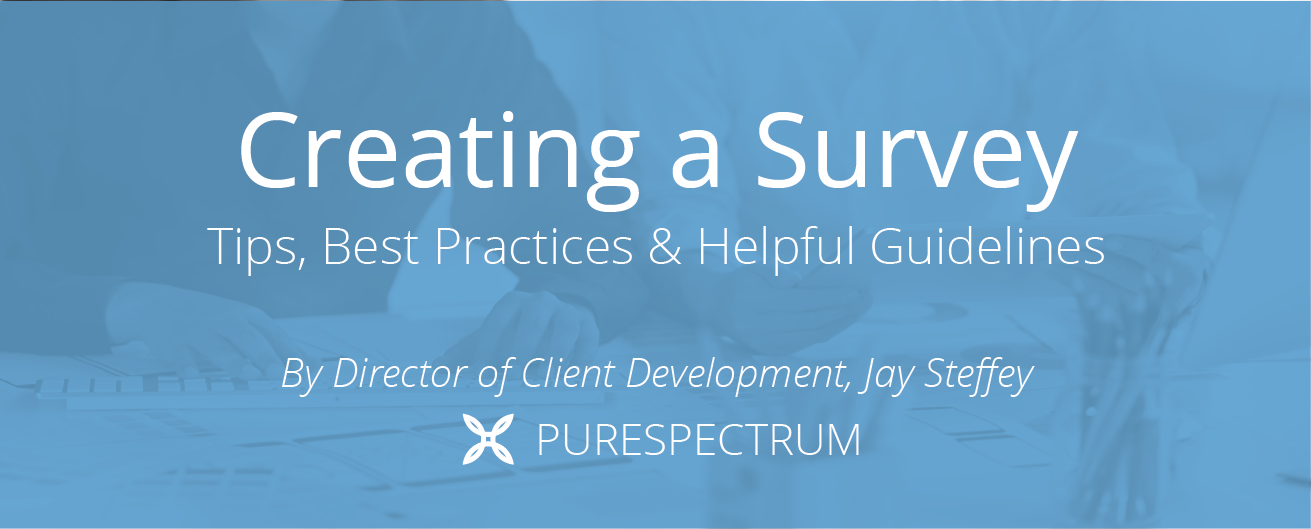

Jay is an industry veteran and has been in the Market Research space for almost 10 years, working with technology and full service insight and data collection companies. He has specialized in working with agencies and universities to use technology to help streamline the survey process, maximize efficiency and optimize their budget. He is currently the Director of Client Development for PureSpectrum based out of New York City supporting the companies clients in the Eastern region.
How Do I Create a Survey? Tips, Best Practices & Helpful Guidelines
What is a Survey?
To survey a group of respondents is to ask them questions on a predefined topic with the intent to gather information for analysis. These insights are then used to generalize across populations to influence decisions including marketing, product design and positioning. Creating effective survey questions is important to ensuring valuable and reliable insights are being gathered.
Selecting Your Methodology
Gathering research insights and creating a survey online is akin to telling a story. Picking the best method to best communicate the story is essential, and can lead to the most usable insights that researchers can use to pivot in the market. The most effective surveys are designed with the intent to understand consumer behavior and how they interpret the world beyond the click of a radio button on a grid. The top tips for creating a good survey are:
Identify the research outcomes.
What does your client want out of their study? Do they want to know their customer’s interest levels in a new show or gather brand comparison analysis? Knowing the desired outcome when creating survey questions is essential to paving the way to get there.
Identify respondent requirements.
Who are the best people to take your survey to get the most reliable results? Are these people the kinds of people your client wants to interview? Will they give your client insights they can act on? Asking a stay-at-home mom questions about grocery store product placement will be more effective than asking a C-Suite executive. This will help you better create a survey, survey questions and survey measurement instruments.
Identify your survey method.
Choosing the right type of survey method for fielding will help you to effectively build out survey questions and format the right reports.
Writing Survey Questions
It is important to effectively create survey questions with the respondent journey in mind. Ensuring that the respondent has a good survey experience can ensure the quality of their responses. Preventing survey fatigue while also keeping questions easy to understand and respond to are vital. When creating survey questions, be sure to keep in mind:
If the questions are directly addressing the survey objective.
Writing a survey with what the generated report needs to look like in mind is essential for good data. Be sure that all questions are absolutely essential to serving the core research objectives and will be able to contribute to painting the big picture for brands.
The complexities of each question, and how the question is asked.
Use everyday language, avoid industry-specific lingo, and don’t create assumptions about the respondent’s ability to understand a specific topic. Unless you are creating a survey online about a specific knowledgeable audience such as asking doctors about types of medication, assume the audience is learning as they go. The use of guides as well as references/examples can make it easier for respondents to understand the intent of the question. Make questions as easy to answer as possible asked one at a time to prevent confusion.
How to best answer the question, and convey that accurately to a respondent.
Don’t assume every respondent is an expert in survey taking. Taking the time to train a respondent in how to answer a question leads to the best outcomes. For example, letting a respondent play with a slider function before showing them the live question allows them to gain a better feel for how they are supposed to answer leading to stronger data sets.
How fatigued the respondent is getting taking your survey.
Answering questions in the exact same format for extended periods of time can be mentally exhausting, leading respondents to speed through questions or select random answers. Using different formats when creating survey questions such as card sorts, videos, rankings, sliders, highlighters, and heat maps can keep respondents more engaged and more likely to provide you with usable insights.
Be aware of stimuli when you ask a question because you might get different answers.
Asking a customer to name one of the Kardashian sisters is different than showing a picture of Kim and asking the respondent if they know who this person is. Unable to name a member of the famous family off the top of their head, a respondent may still recognize Kim Kardashian from a photo. People take pictures with their minds and can recall information more easily when prompted. Be sure to control what the respondent sees to better answer directly what the client is asking for.
Up to 50% of respondents are taking this survey on a mobile device.
Do you really need to name all 90 brands of brown rice for your awareness survey, or can you name the top 10 that cover 90% of the market? Keeping things shorter when creating survey questions allows for a more mobile-friendly experience while still allowing researchers to capture valuable data.
Keep it fun!
Throwing in mad-lib style questions, asking people what kind of car best describes this department store brand or to describe their life in one photo can keep survey respondents engaged while adding color to a segment. Even though these are lots of fun and help with engagement, they also can help get a more organic read on how people make decisions.
Executing Your Survey
After you’ve created your survey, you’ll need respondents to answer them. Today, technologies are available to create a survey online, design better questions and capture insights that truly address the core research question. Seamless experiences are possible through survey software redirects and automated sampling platforms, engaging respondents in new ways for even better conversion.
At PureSpectrum, gain access to 40+ integrated panels in 50+ worldwide markets. With integration capabilities into any survey software, the PureSpectrum Marketplace offers a streamlined experience with only the right respondents. Reduce quota terminations, reconciliation rates and time to get in and out of field, allowing you to get research answers faster.
To learn more about fielding your study, integrating into survey softwares or accessing your projects feasibility, contact us today.
